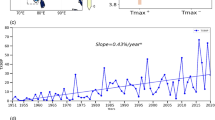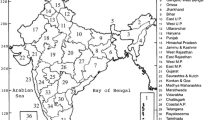Abstract
Using gauge data during 1979–2013, the spatial and temporal characteristics of winter clear-sky days (CSDs) in China are investigated. The frequency of winter CSDs in China has two independent and significant modes, which account for 41% and 10% of the total variance, respectively. Based on evidence from observational analysis and numerical experiments, the formation mechanisms of these two leading modes are unraveled. The first mode is a homogenous mode with coherent year-to-year variation of CSDs over most parts of China, and is closely related to a large-scale cyclonic/anticyclonic anomaly over the Asian continent. Anomalous Indian Ocean SST and Arctic sea ice are responsible for the associated large-scale circulation anomalies via inducing a mid-to-high latitude Rossby wave train. The Indian Ocean SST warming can induce wave energy propagation upwards to the stratosphere and then northwards to the polar region, where it moves down to the troposphere and then travels southeastwards from the polar region to East Asia. Meanwhile, the decreased Arctic sea ice can directly induce a Rossby wave train emanating from the polar region that travels southeastwards into East Asia. These two factors jointly lead to a dominant equivalent barotropic cyclonic/anticyclonic anomaly over China, and in turn the homogenous pattern of winter CSDs in the region. The second mode is a seesaw mode with out-of-phase variations of CSDs between northern and southern China. This mode is closely related to a meridional dipole circulation anomaly pattern over the East Asian sector, which is generated by the so-called ‘Mega-ENSO’ SST anomaly over the Pacific Ocean. This Mega-ENSO SSTA pattern can induce convective heating/cooling over the tropical western Pacific, which further leads to the meridional dipole circulation anomaly pattern over the East Asian sector, resulting in the south-to-north seesaw mode of winter CSDs in China.














Similar content being viewed by others
References
Adler RF, Huffman GJ, Chang A, Ferraro R, Xie PP, Janowiak J, Rudolf B, Schneider U, Curtis S, Bolvin D et al (2003) The version-2 global precipitation climatology project (GPCP) monthly precipitation analysis (1979-present). J Hydrometeorol 4(6):1147–1167
Bajuk LJ, Leovy CB (1998) Seasonal and interannual variations in stratiform and convective clouds over the tropical Pacific and Indian Oceans from ship observations. J Clim 11(11):2922–2941
Betts AK, Desjardins R, Worth D (2013) Cloud radiative forcing of the diurnal cycle climate of the Canadian Prairies. J Geophys Res Atmos 118:8935–8953
Chen W, Lan XQ, Wang L, Ma Y (2013) The combined effects of the ENSO and the Arctic oscillation on the winter climate anomalies in East Asia. Chin Sci Bull 58:1355–1362
Dai AG (2006) Precipitation characteristics in eighteen coupled climate models. J Clim 19(18):4605–4630
Ding YH, Chan JCL (2005) The East Asian summer monsoon: an overview. Meteorol Atmos Phys 89(1–4):117–142
Eastman R, Warren SG, Hahn CJ (2011) Variations in cloud cover and cloud types over the ocean from surface observations, 1954–2008. J Clim 24(22):5914–5934
Eguchi N, Yokota T (2008) Investigation of clear-sky occurrence rate estimated from CALIOP and MODIS observations. Geophys Res Lett 35(23)
Endo N, Yasunari T (2006) Changes in low cloudiness over China between 1971 and 1996. J Clim 19:1204–1213
Gill AE (1980) Some simple solutions for heat-induced tropical circulation. Q J R Meteorol Soc 106:447–462. doi:https://doi.org/10.1002/qj.49710644905
Gong DY, Wang SW, Zhu JH (2001) East Asian winter monsoon and Arctic oscillation. Geophys Res Lett 28:2073–2076
Hofer S, Tedstone AJ, Fettweis X, Bamber JL (2017) Decreasing cloud cover drives the recent mass loss on the Greenland Ice Sheet. Sci Adv 3(6):e1700584. doi:https://doi.org/10.1126/sciadv.1700584
Juzeniene A, Brekke P, Dahlback A, Andersson-Engels S, Reichrath J, Moan K, Holick M, Grant W, Moan J (2011) Solar radiation and human health. Rep Prog Phys 74:66701–66757
Kaiser DP (1998) Analysis of total cloud amount over China, 1951–1994. Geophys Res Lett 25(19):3599–3602
Kaiser DP (2000) Decreasing cloudiness over China: an updated analysis examining additional variables. Geophys Res Lett 27(15):2193–2196
Karl TR, Kukla G, Gavin J (1987) Recent temperature changes during overcast and clear skies in the United States. J Climate Appl Meteor 26:698–711
King MD, Platnick S, Menzel WP, Ackerman SA, Hubanks PA (2013) Spatial and temporal distribution of clouds observed by MODIS onboard the Terra and Aqua satellites. IEEE Trans Geosci Remote Sens 51:3826–3852
Li S, Bates GT (2007) Influence of the Atlantic multidecadal oscillation on the winter climate of East China. Adv Atmos Sci 24:126–135
Li J, Wang B, Yang YM (2020) Diagnostic metrics for evaluating model simulations of the East Asian monsoon. J Clim 33:1777–1801
Lim YK, Kim HD (2013) Impact of the dominant large-scale teleconnections on winter temperature variability over East Asia. J Geophys Res 118:7835–7848. doi:https://doi.org/10.1002/jgrd.50462
Liu Y, Key JR, Francis JA, Wang X (2007) Possible causes of decreasing cloud cover in the Arctic winter, 1982–2000. Geophys Res Lett 34(14)
Liu G, Ji LR, Wu RG (2012) An east-west SST anomaly pattern in the midlatitude North Atlantic Ocean associated with winter precipitation variability over eastern China. J Geophys 117:D15104. https://doi.org/10.1029/2012JD017960
Lorenz EN (1956) Empirical orthogonal functions and statistical weather prediction. Department of Meteorology, MIT Statistical Forecast Project Rep 1
Norris JR (2005) Trends in upper-level cloud cover and surface divergence over the tropical Indo-Pacific Ocean between 1952 and 1997. J Geophys Res 110(D21)
North GR, Bell TL, Cahalan RF, Moeng FJ (1982) Sampling errors in the estimation of empirical orthogonal functions. Mon Weather Rev 110:699–706
Pincus R, Platnick S, Ackerman SA, Hemler RS, Patrick Hofmann RJ (2012) Reconciling simulated and observed views of clouds: MODIS, ISCCP, and the limits of instrument simulators. J Clim 25(13):4699–4720
Qian Y, Kaiser DP, Leung LR, Xu M (2006) More frequent cloud-free sky and less surface solar radiation in China from 1955 to 2000. Geophys Res Lett 33
Rayner NA, Parker DE, Horton EB, Folland CK, Alexander LV, Rowell DP, Kent EC, Kaplan A (2003) Global analyses of sea surface temperature, sea ice, and night marine air temperature since the late nineteenth century. J Geophys Res 108:4407. https://doi.org/10.1029/2002JD002670
Roeckner E, Arpe K, Bengtsson L, Christoph M, Claussen M, Dümenil L, Esch M, Giorgette M, Schlese U, Schulzweida U (1996) The atmospheric general circulation model ECHAM-4: model description and simulation of present-day climate. MPI report 218, Max-Planck-Institut für Meteorologie
Simmons A, Uppala S, Dee D, Kobayashi S (2006) Era-interim: new ecmwf re-analysis products from 1989 onwards. ECMWF Newslett 110:2535
Takaya K, Nakamura H (2001) A formulation of a phase-independent wave-activity flux for stationary and migratory quasigeostrophic eddies on a zonally varying basic flow. J Atmos Sci 58:608–627
Tang Q, Leng G (2013) Changes in Cloud Cover, Precipitation, and Summer Temperature in North America from 1982 to 2009. J Clim 26(5):1733–1744
Udelhofen PM, Cess RD (2001) Cloud cover variations over the United States: An influence of cosmic rays or solar variability? Geophys Res Lett 28(13):2617–2620
Wang H, He S (2012) Weakening relationship between East Asian winter monsoon and ENSO after mid-1970s. Chin Sci Bull 57:3535–3540
Wang B, Liu J, Kim HJ, Webster PJ, Yim SY, Xiang B (2013) Northern Hemisphere summer monsoon intensified by Mega-El Nino/Southern Oscillation and Atlantic multidecadal oscillation. Proc Natl Acad Sci USA 110:5347–5352
Warren S, Eastman R, Hahn C (2007) A survey of changes in cloud cover and cloud types over land from surface observations. 1971–1996. J Clim 20(4):717–738
Wylie D, Jackson DL, Menzel WP, Bates JJ (2005) Trends in global cloud cover in two decades of HIRS observations. J Clim 18(15):3021–3031
Xiao D, Zuo Z, Zhang R, Zhang X, He Q (2018) Year-to-year variability of surface air temperature over China in winter. Int J Climatol 38(4):1692–1705
Xia X (2010) Spatiotemporal changes in sunshine duration and cloud amount as well as their relationship in China during 1954–2005. J Geophys Res 115
Xia X (2012) Significant decreasing cloud cover during 1954–2005 due to more clear-sky days and less overcast days in China and its relation to aerosol. Annales Geophysicae 30(3):573–582
Zhou L, Wu R (2015) Interdecadal variability of winter precipitation in Northwest China and its association with the North Atlantic SST change. Int J Climatol 35:1172–1179
Zhu Z, Li T (2016) A new paradigm for the continental United States summer rainfall variability: Asia–North America teleconnection. J Clim 29:7313–7327
Zhu Z, Li T, He J (2014) Out-of-phase relationship between boreal spring and summer decadal rainfall changes in southern China. J Clim 27:1083–1099
Acknowledgements
This work was supported by the National Key R&D Program of China (2018YFC1505905), the National Natural Science Foundation of China (42005115). ZZ is sponsored by the Young Elite Scientists Sponsorship Program of CAST (2018QNRC001) and the Huai-River Meteorological Founding (HRM201801). LL and TH are sponsored by the Jiangsu Province College Students Innovation and Entrepreneurship Training Program (201910300098Y).
Author information
Authors and Affiliations
Corresponding author
Additional information
Publisher's Note
Springer Nature remains neutral with regard to jurisdictional claims in published maps and institutional affiliations.
Rights and permissions
About this article
Cite this article
Yan, H., Pan, X., Zhu, Z. et al. The two leading modes of winter clear-sky days over China and their formation mechanisms. Clim Dyn 56, 189–205 (2021). https://doi.org/10.1007/s00382-020-05470-5
Received:
Accepted:
Published:
Issue Date:
DOI: https://doi.org/10.1007/s00382-020-05470-5




